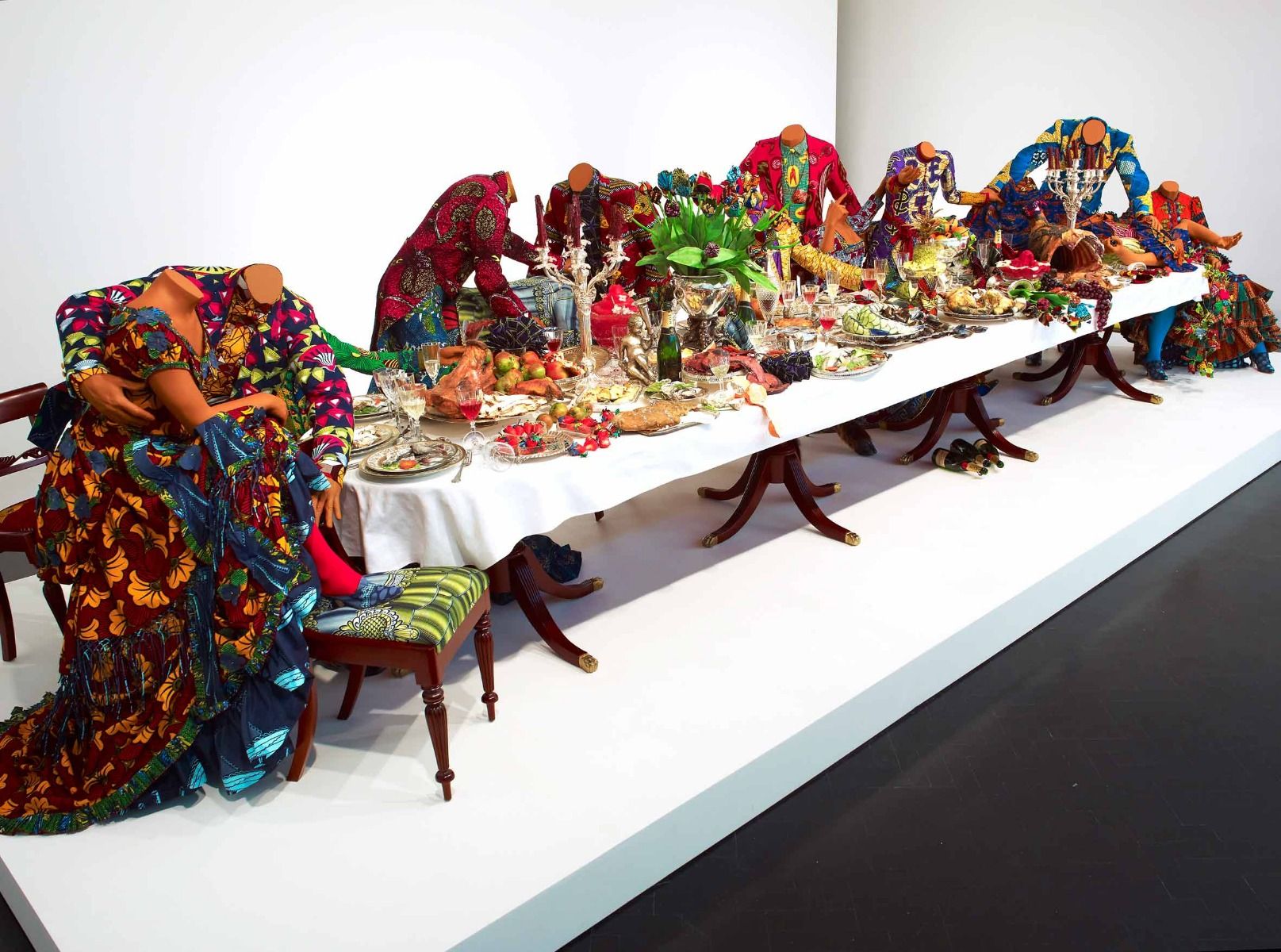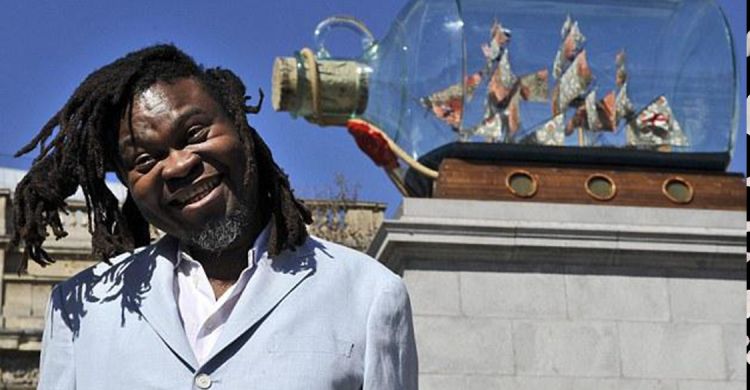

Yinka Shonibare
Last Supper

Fate
Yinka’s father is a successful lawyer. He doesn't want his son to go to art school. But Yinka doesn’t give up easily; he's going anyway. When Yinka has just started at art school, he comes down with a rare infection. It damages his spine. For a time he is paralysed, completely unable to move. Today, he is still paralysed on one side of his body, but he refuses to let it keep him down.
Important moment
The last supper is a famous story from the Bible. Perhaps you know it. Jesus calls his 12 disciples together. He knows that one of them, Judas, will betray him and that this will be his last supper. Jesus washes his disciples' feet and shares bread and wine. Artists have often chosen this event as a subject. A world-famous example is Leonardo da Vinci's mural, which is more than 500 years old. Yinka had it in mind when he created his own artwork. This sculpture is a tribute to Leonardo da Vinci.
Party!
The Last Supper has a long history. In this sculpture, it is not Jesus who plays the leading role but Bacchus, the god of wine and drunkenness. Bacchus threw wild parties known as Bacchanalia. There was lots of wine and loud music. People wore wooden masks and put leaves on their faces. They coloured their bodies in all sorts of shades of green and red, and they wrapped sheepskins and goatskins around their hips.
Jesus becomes a satyr
In this sculpture created by Yinka, Bacchus is not a half-god but a satyr. You can see him sitting in the middle. A satyr is a being with the legs of a goat and the upper body of a man. Do you see his goat hooves under the table? Satyrs played a role in Ancient Greek and Roman myths. The myths are exciting, well-known stories, but we can't be certain whether they really happened.
Special character
This cheeky and cheerful demigod plays the main role in the sculpture. He loves wine and thinks that feeling is more important than thinking. The satyr also privileges chaos ahead of tidiness and believes pleasure trumps self-control. He is malicious and drinks too much wine, so it is not clear whether he can be trusted. He is constantly trying to seduce nymphs and demigoddesses as well as ephebe, young men who haven't yet started to grow beards.
Did you know?
The word 'satire' is derived from satyr. Satire mocks someone or something, often in an exaggerated way.
Surprise
Yinka uses radiant materials that display the pride and uniqueness of Africa. The only thing is that the materials don't come from Africa at all but from the Netherlands! That's the crazy thing. They were made when Indonesia was still a Dutch colony and were intended for people from Indonesia. But few bought the fabrics, so they were sold in Africa. People loved the fabrics there and bought them. Yinka raises questions with these materials: what is African and what is European?
Self-devised
The materials that Yinka uses became popular in Africa. They look like they came from Asia but were made here in the Netherlands. Culture is actually a human invention. It's not a fact, like 2+3=5.
Faceless
As you can see, the figures at the table here have no faces. Yinka is raising questions about origin and race. It's a subject that Yinka thinks about a lot. Who's sitting at the table? It's a mystery. People, animals, Europeans, Africans, Asians or perhaps even Native Americans?
Bulb industry
As you can see, there are two silver vases of tulips on the table. During the Golden Age, flower bulbs were incredibly valuable. Then the industry collapsed and the bulbs were not worth a cent.
A rich life
When Yinka creates art, the countries in which he has lived are always with him. So are the ways of life that he knows. He was born in England but has also lived in Nigeria. Although we inhabit just one planet, it contains many different worlds and each one has its own habits and customs.
Your own idea
Yinka says, "I think you can see 'happiness' and 'sadness' at the same time in my work. People can also recognise certain things themselves. So, it can be a beautiful dream, or it can sometimes be a dark dream, a nightmare. I don't tell people how they should look at something."
Violence
This big dinner that harks back to the Last Supper says even more. It also brings to mind all the people who were murdered during the French Revolution. There was a lot of corruption in those days, just as there has been among the banking industry bosses more recently. And excesses as well: too much food and too much drink.
Through the ages
This sculpture reaches its arms out to today, but it is a younger brother of an ancient story from the Bible. You can do that with art. The sculpture has so much meaning that it says something about the past, the present and the future. The behaviour you see here is part of human nature, regardless of the age in which we live.
Bank bosses
People who work in highly-paid positions in banks are not especially popular. They often put a lot of money in their own pockets, especially the people at the top. This type of behaviour is part of the 'greed culture': certain people only care about raking in huge amounts of money, while forgetting about the work they are supposed to do. This was the starting point for Yinka's artwork. In his sculpture, the bank staff have abandoned their work. You can see how they throw money around. There are oysters and champagne bottles on the table.
Have you ever been to this type of boisterous party? You can get a good look at everyone. They're frozen in the moment. This is also seen in plays. A situation where everyone stands still like this is called a tableau. They sit and lie around without being at all self-conscious.
Man and woman
The peak years of the Rococo period were between 1730 and 1760. During this time, heavily curled and playful decorations were extremely popular. Jean-Honoré Fragonard is a painter from the Rococo period. In 1767, he painted an important work: ‘The Swing’. In 2001, Yinka also created his own artwork with the same title. It was exhibited in a famous gallery in London. As with the Last Supper, Yinka made use of an age-old story.
Yinka uses a doll that sits on a swing. The doll is wearing a colourful dress sewn from African fabrics and has no head. Many French nobles were murdered by guillotine after the French Revolution, which was 25 years after Fragonard painted ‘The Swing’. This was why Yinka chose to make the woman headless.
Variety
Yinka doesn't create just one type of art. He does paintings, takes photos and creates installations, sculptures and films.
Playing a game
There is a very old idea known as homo ludens. It's a Latin term meaning 'playing human'.
Yinka is keen to show the world how he thinks. He is not only serious and a hard worker, but he's also a ‘playing human’. Yinka hopes that by playing and trying things out, cheerfully and with bright colours, people can be inspired to think in a different way. This is his way of campaigning. As a thinker and a doer with small actions and a lot of thought.
Deep inside
Yinka says, "I have a love-hate relationship with people in authority. I have something against them. But deep down I secretly want to be one of them. You could say it's the troublemaker in me."
video of Tate Modern about Yinka
Click here to watch this film about Yinka Shonibare made for Tate Modern in London.
https://www.tate.org.uk/kids/explore/who-is/who-yinka-shonibare
Imagine this artwork in your house. Where would you place it or hang it?



